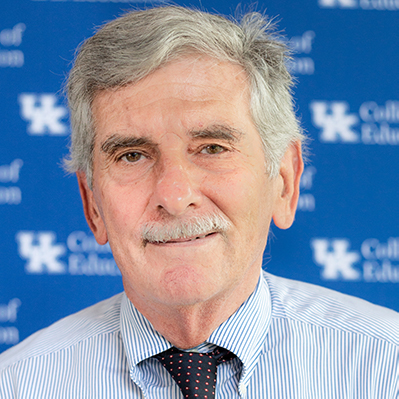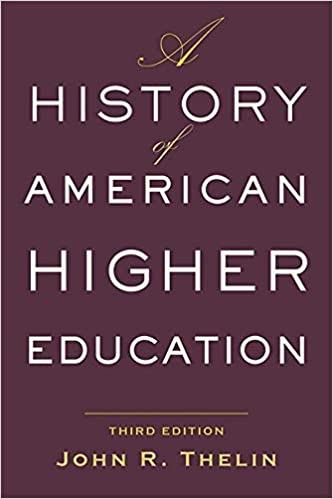You have /5 articles left.
Sign up for a free account or log in.
John Thelin is the University Research Professor in History of Higher Education & Public Policy in the Department of Educational Policy Studies and Evaluation at the University of Kentucky. You likely know him as the author of A History of American Higher Education, which in April of 2019 was updated with a third edition. John wrote me the most gracious and collegial of notes after seeing my recent review. I asked John if he would be willing to participate in a Q&A, and he generously agreed.
2019 was updated with a third edition. John wrote me the most gracious and collegial of notes after seeing my recent review. I asked John if he would be willing to participate in a Q&A, and he generously agreed.
Q: What was the path that led you to become a historian of higher education?
A: As an undergraduate at Brown University from 1965 to 1969, I concentrated in European history, with added courses in American history and in sociology. Across the various centuries, nations and events, I frequently gravitated to ask how social, economic and political trends meshed with colleges and universities of the time and place. When I entered graduate school at the University of California, Berkeley, I refined that emphasis. Berkeley was a wonderful place to meet, listen to and work with some of the outstanding historians, economists and sociologists who happened to be studying higher education. I was fortunate to have them as mentors -- and was introduced to them by my adviser, Geraldine Joncich Clifford -- a superb historian of education. I owe a special debt to Harvard sociologists David Riesman and Christopher Jencks for their provocative 1968 work, The Academic Revolution. Also timely was historian Frederick Rudolph of Williams College, who wrote a classic work, The American College and University: A History. He later became a mentor and colleague who always encouraged me to write about the history of higher education.
Perhaps the most distinctive part of my entrance into the study of higher education was my asking questions about how and where college sports fit into the story. My faculty advisers shrugged their shoulders, suggesting they did not know a lot nor have much to say about the topic -- but they encouraged me to pursue it my own original research. Since I had been serious about college sports as a varsity wrestler and long-distance runner, this topic percolated -- and has been integral to my teaching and scholarship ever since.
Q: Going forward, how might we transcend the divide between scholars of higher education (such as yourself) and those nonfaculty educators (staff/administrators) with higher education leadership roles?
A: For myself, I do not feel a divide. That’s because in my work in higher education I have held several administrative roles -- assistant dean of admissions, assistant director of college relations, research director for California’s 64 independent colleges and universities, and work in both Washington, D.C., and California in public policy and government relations. Also, as a professor at the College of William & Mary, I served as president of the Faculty Assembly and liaison to the Board of Visitors. These roles provided good experience and observation about governance of the American campus and their national associations.
both Washington, D.C., and California in public policy and government relations. Also, as a professor at the College of William & Mary, I served as president of the Faculty Assembly and liaison to the Board of Visitors. These roles provided good experience and observation about governance of the American campus and their national associations.
So, I always try to bridge the divide. I’ve had some inspiring mentors and colleagues who led by example. Howard R. Bowen was a great president of a flagship state university and a prestigious liberal arts college -- and always found time to teach and do incredible research on the economics of higher education. The late William Bowen, president and provost at Princeton, remained involved in higher education research. Consider the contributions of a Patricia Albjerg Graham as an outstanding historian of education who also served as director of the National Institute of Education, president of the Spencer Foundation and dean of Harvard Graduate School of Education. Michael Crow writes and reads about the present and future of higher education while serving as a university president. The late Myles Brand, who was a university president and president of the NCAA, was a great advocate for serious research on higher education, including intercollegiate sports and public policy. In my own age cohort, I have the greatest respect for Linda Eisenmann, who has been provost and professor at Wheaton College in Massachusetts. Stanley Katz of Princeton, Michael A. Olivas of the University of Houston, Bill Tierney of the University of Southern California, Marybeth Gasman of Rutgers and Elizabeth Whitt of the University of California embody to me the ideal and realization of public intellectuals who are leaders in higher education governance and scholarship.
So, I think the divide of administrators versus professors is unfortunate and unnecessary -- and a false dichotomy. I do wonder what presidents, provosts, deans and trustees like to read about higher education. It’s such an exciting field with numerous great writers and analysts. And, thanks to excellent editors and writers, I think Inside Higher Ed would be a good place for leaders to consider reading frequently. The next step would before them then to extend that curiosity into reading more detailed articles, books and policy reports.
Q: What are your thoughts about how higher education might be different after COVID-19?
A: Hardly original to me is the observation that COVID-19 accelerated numerous trends that already were in place throughout higher education. Reliance on and creative use of internet and distance learning is a central, obvious legacy. Resilience in providing services and instruction and other programming are in the mix. I do think college and university presidents and trustees who a decade ago “bought in” to massive, monumental campus architecture in scope and indebtedness were susceptible to overreliance on enrollment growth and other “business as usual” syndromes. Higher education will carry the legacy of campus expansion and spending for some time.
For futurists who do choose to read about the history of higher education, I hope one influence will be to temper the lure of making overly bold projections. I try to pay attention to subtle details and nuances along with studying demographic trends. Dramatic individuals and innovations that make headlines usually are accompanied by unexpected consequences and some disappointments.
The pandemic will, I think, accentuate disparities within potential college student groups and within the ranks of institutions. Advantages afforded by heritage, wealth, race, ethnicity and merit will gain increased influence.








